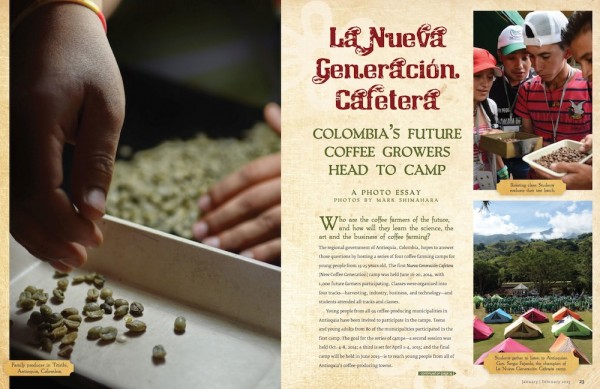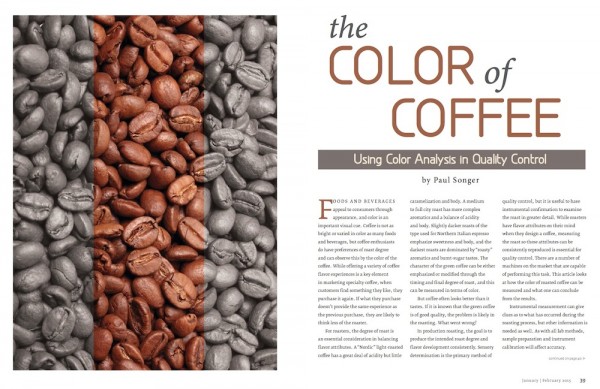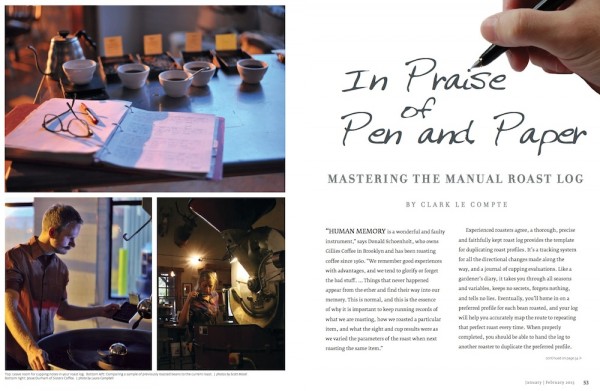The January/February 2015 issue of Roast Magazine is now shipping. If you’re not yet a Roast subscriber, become one here.
Below are previews of three of this issue’s feature stories, including a look at a new generation of farmers in Antioquia, Colombia, with a photo essay from Mark Shimahara, an exploration of color analysis in quality control by Paul Songer, and thoughts on manual roast logging from Clark Le Compte.
Read. Learn. Enjoy. Subscribe.
LA NUEVA GENERACIÓN CAFETERA
Colombia’s Future Coffee Growers Head to Camp
a Photo Essay
Photos by Mark Shimahara
Who are the coffee farmers of the future, and how will they learn the science, the art and the business of coffee farming?
The regional government of Antioquia, Colombia, hopes to answer those questions by hosting a series of four coffee farming camps for young people from 15-25 years old. The first Nueva Generación Cafetera (New Coffee Generation) camp was held June 16-20, 2014, with 1,000 future farmers participating. Classes were organized into four tracks—harvesting, industry, business, and technology—and students attended all tracks and classes.
THE COLOR OF COFFEE
Using Color Analysis in Quality Control
by Paul Songer
FOODS AND BEVERAGES appeal to consumers through appearance, and color is an important visual cue. Coffee is not as bright or varied in color as many foods and beverages, but coffee enthusiasts do have preferences of roast degree and can observe this by the color of the coffee. While offering a variety of coffee flavor experiences is a key element in marketing specialty coffee, when customers find something they like, they purchase it again. If what they purchase doesn’t provide the same experience as the previous purchase, they are likely to think less of the roaster.
For roasters, the degree of roast is an essential consideration in balancing flavor attributes. A “Nordic” light-roasted coffee has a great deal of acidity but little caramelization and body. A medium to full city roast has more complex aromatics and a balance of acidity and body. Slightly darker roasts of the type used for Northern Italian espresso emphasize sweetness and body, and the darkest roasts are dominated by “roasty” aromatics and burnt-sugar tastes. The character of the green coffee can be either emphasized or modified through the timing and final degree of roast, and this can be measured in terms of color.
IN PRAISE OF PEN AND PAPER
Mastering the Manual Roast Log
by Clark Le Compte
“HUMAN MEMORY is a wonderful and faulty instrument,” says Donald Schoenholt, who owns Gillies Coffee in Brooklyn and has been roasting coffee since 1960. “We remember good experiences with advantages, and we tend to glorify or forget the bad stuff… Things that never happened appear from the ether and find their way into our memory. This is normal, and this is the essence of why it is important to keep running records of what we are roasting, how we roasted a particular item, and what the sight and cup results were as we varied the parameters of the roast when next roasting the same item.”
Experienced roasters agree, a thorough, precise and faithfully kept roast log provides the template for duplicating roast profiles. It’s a tracking system for all the directional changes made along the way, and a journal of cupping evaluations. Like a gardener’s diary, it takes you through all seasons and variables, keeps no secrets, forgets nothing, and tells no lies. Eventually, you’ll home in on a preferred profile for each bean roasted, and your log will help you accurately map the route to repeating that perfect roast every time. When properly completed, you should be able to hand the log to another roaster to duplicate the preferred profile.
Nick Brown
Nick Brown is the editor of Daily Coffee News by Roast Magazine.









Comment